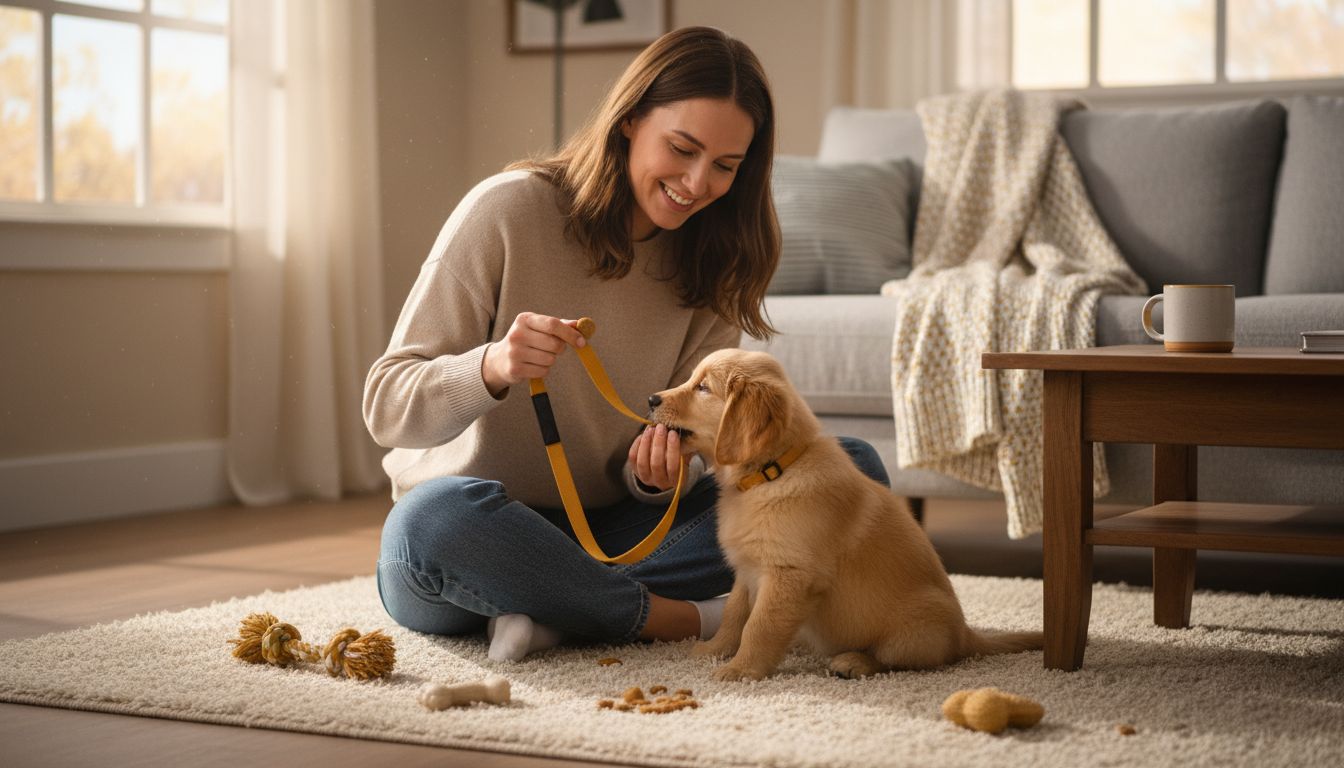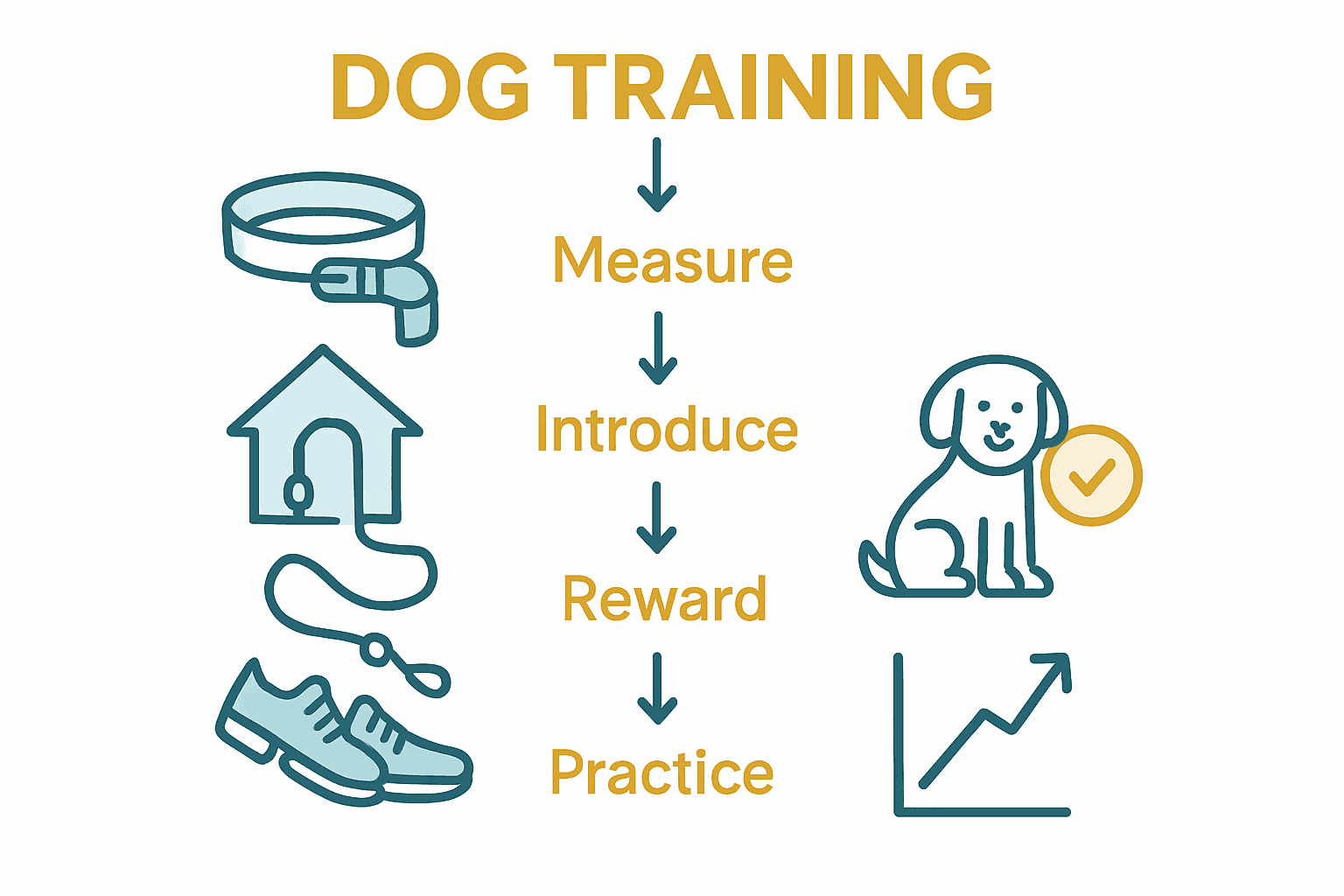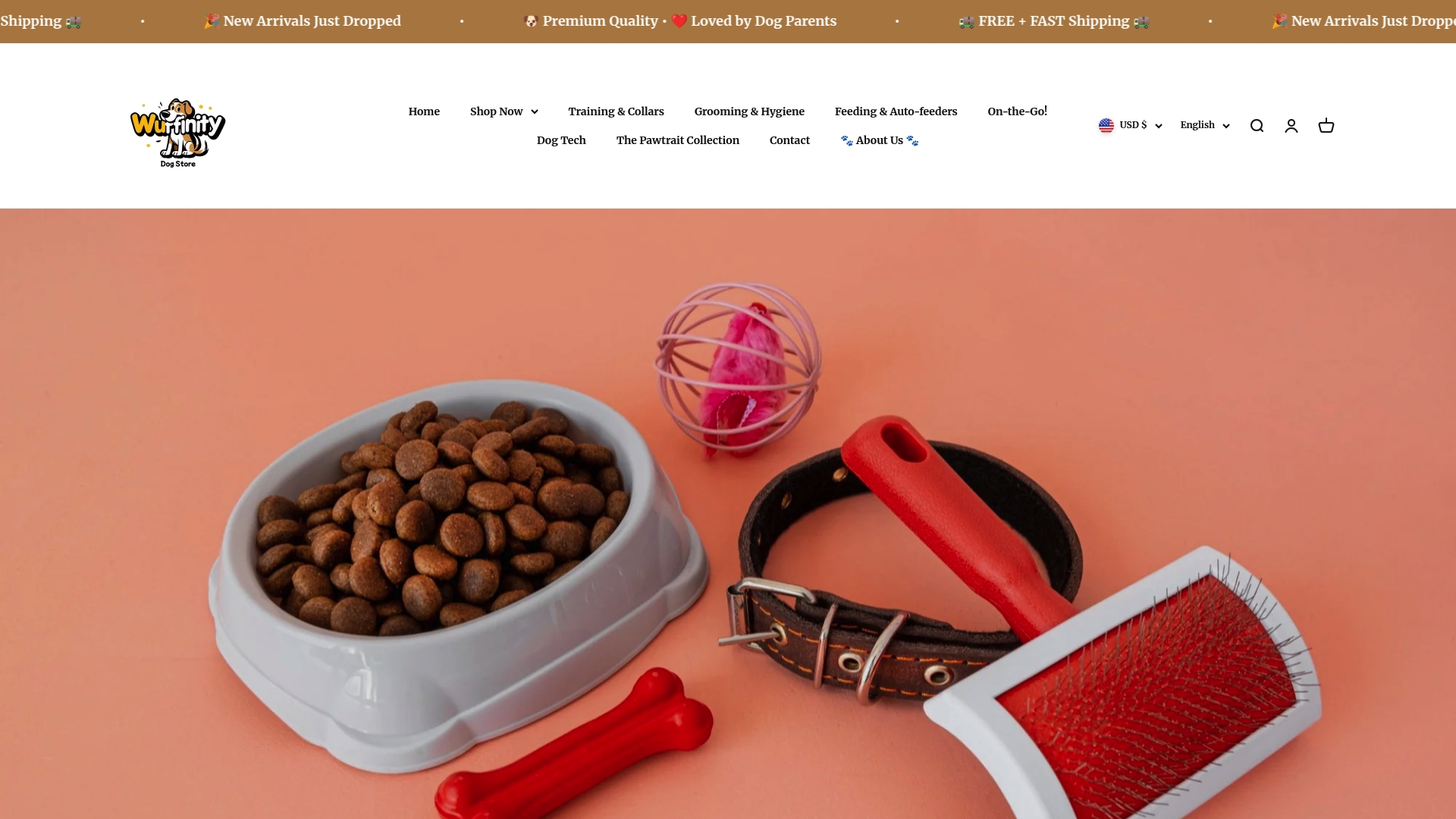Nearly one in five dogs will try to slip out of their collars during walks, turning a simple outing into a stressful ordeal. Selecting the right leash and collar goes far beyond just picking colors or styles. The proper fit and choice can prevent injuries, keep your dog secure, and make every walk more enjoyable. Learn how simple techniques and the right equipment can lay the foundation for stress-free adventures with your dog.
Table of Contents
- Step 1: Select and Fit the Right Leash and Collar
- Step 2: Introduce the Leash in a Safe Space
- Step 3: Encourage Calm Behavior Before Walking
- Step 4: Practice Controlled Walking Techniques
- Step 5: Verify Progress and Adjust Training Methods
Quick Summary
| Key Point | Explanation |
|---|---|
| 1. Measure for the right collar fit | Ensure a collar allows for two fingers to fit comfortably for safety and comfort. |
| 2. Use a 4-6 foot leash for control | Standard leashes prevent pulling and maintain control during walks. |
| 3. Introduce the leash gradually | Allow your dog to explore the leash in a distraction-free space to build comfort. |
| 4. Reinforce calm behavior before walks | Wait for your dog to settle before attaching the leash to promote calmness. |
| 5. Observe and adjust training methods | Monitor body language and adjust techniques based on your dog’s stress levels. |
Step 1: Select and Fit the Right Leash and Collar
Choosing the right leash and collar is your first crucial step toward stress-free dog walks. This process involves selecting equipment that ensures your dog’s comfort, safety, and your control during outdoor adventures.
According to the American Kennel Club, accurately measuring your dog’s neck is essential for proper collar fit. Use a soft measuring tape to determine your dog’s neck circumference, then select a collar that allows two fingers to fit comfortably between the collar and neck. This technique prevents both potential injuries and unexpected escapes. When measuring, make sure the collar is snug but not restrictive.
For leash selection, consider your dog’s size, strength, and walking behavior. A standard 4-6 foot leash works best for most dogs, providing enough freedom while maintaining control. Nylon and leather leashes offer durability and comfort, with nylon being lighter and leather developing a softer feel over time. Avoid retractable leashes for training, as they can encourage pulling and reduce your control.
A key tip from the International Wildlife Conservation Trust suggests adding an extra 1-3 inches to your neck measurement based on your dog’s size. For smaller dogs, add 1 inch to allow room for growth and comfort. For larger breeds, add up to 3 inches to ensure a proper fit.
Once you’ve selected the right leash and collar, you’re ready to move on to the next phase of leash training. Your goal is creating a comfortable, secure setup that sets the foundation for enjoyable walks together.
Step 2: Introduce the Leash in a Safe Space
Now that you have the right leash and collar, it is time to help your dog become comfortable with these new accessories. The goal of this step is to create a positive, stress-free introduction to leash wearing that will set the foundation for future walking success.
PAWS Chicago recommends introducing the leash in a quiet, distraction-free environment. Start by letting your dog explore the leash naturally. Allow them to sniff and investigate it without forcing any interaction. This approach helps prevent anxiety and builds curiosity about the new object.
Begin by placing the leash near your dog during calm moments, such as when they are relaxing or enjoying a treat. Reward your dog with small treats when they show calm behavior around the leash. Gradually progress to holding the leash near them and eventually attaching it briefly indoors. As Every Dog Austin suggests, keep these initial sessions short and positive.
A helpful tip is to associate the leash with something enjoyable. Bring out their favorite treats or toy when you introduce the leash. This creates a positive emotional connection and helps your dog view the leash as something exciting rather than restrictive. Patience is key dogs learn at different paces, so dont rush the process.
Once your dog seems comfortable with the leash indoors, youre ready to move to the next stage of training. The goal is a confident, relaxed dog who sees the leash as a gateway to fun adventures.

Step 3: Encourage Calm Behavior Before Walking
Before stepping outside, establishing a calm and controlled environment is crucial for successful leash training. Your goal is to teach your dog that excited behavior will not immediately result in a walk.
According to American Humane, the key is to wait for your dog to sit or stand calmly before attaching the leash and starting the walk. This approach reinforces that calm behavior leads to positive outcomes. When your dog becomes excited or starts jumping around, simply stand still and wait. Do not engage or speak to them until they settle down.
The San Diego Humane Society recommends practicing this technique consistently. Begin by picking up the leash but only attaching it when your dog is completely calm. If they become overly excited, put the leash down and wait. This teaches your dog that their behavior directly influences when the walk begins.
A helpful tip is to practice this routine multiple times a day, even if you do not go for a full walk. Short training sessions help reinforce the concept that calmness is rewarded. Use treats and gentle praise when your dog demonstrates the desired behavior, making the learning process enjoyable and positive.
Once your dog consistently demonstrates calm behavior before walks, you are ready to move to the next phase of leash training. Remember that patience and consistency are your greatest tools in creating a well behaved walking companion.
Step 4: Practice Controlled Walking Techniques
Controlled walking is an essential skill that transforms chaotic walks into enjoyable experiences for both you and your dog. This stage focuses on teaching your dog to walk smoothly and attentively beside you without constant pulling or wandering.
PAWS Chicago recommends using a specific training cue they call the ‘Let’s Go’ command. Start in a quiet area with minimal distractions. Hold treats close to your side and encourage your dog to walk near you. When they stay close, immediately reward them with treats and verbal praise. This helps your dog understand that staying beside you is rewarding.
Every Dog Austin suggests implementing the ‘Red Light/Green Light’ technique to discourage pulling. When your dog starts to pull ahead, stop walking completely. Stand still and wait until the leash becomes slack. Only resume walking when the leash is loose and your dog is paying attention to you. This teaches your dog that pulling will not get them where they want to go.
A critical tip is to keep training sessions short and positive. Aim for 10 to 15 minute practice periods to prevent frustration for both you and your dog. Use high value treats and maintain an enthusiastic tone to keep the training engaging. As your dog improves, gradually introduce more distracting environments to test and reinforce their new walking skills.
Once your dog consistently walks calmly beside you with minimal pulling, youre ready to explore more challenging walking scenarios. Remember that consistency and patience are key to successful leash training.
Step 5: Verify Progress and Adjust Training Methods
Leash training is an ongoing process that requires careful observation and flexibility. Your goal is to create a positive walking experience that evolves with your dogs unique learning style and personality.
According to the Humane Society of the Pikes Peak Region, monitoring your dogs body language is crucial for assessing training progress. Watch for signs of stress such as excessive panting, tail tucking, or avoiding eye contact. These indicators suggest you may need to modify your training approach or slow down the difficulty level.
The San Diego Humane Society emphasizes the importance of gradual progression. Start by tracking specific metrics like the duration of calm walking, frequency of pulling, and your dogs overall comfort level. Create a simple log to record improvements and challenges. This documentation helps you recognize patterns and make informed adjustments to your training strategy.
A helpful tip is to introduce small challenges incrementally. If your dog performs well in quiet environments, slowly add mild distractions like walking near low traffic areas or during quieter times of day. Pay attention to how your dog responds and be prepared to return to previous training stages if they seem overwhelmed.
Consider seeking professional guidance if you encounter persistent challenges. A certified dog trainer can provide personalized strategies tailored to your dogs specific needs and temperament.
Equip Yourself for Stress-Free Dog Walks Today
Leash training your dog can feel overwhelming when trying to balance comfort, control, and calm behavior. This article highlights the essential steps to select the right leash and collar, gently introduce these tools, and practice calm walking techniques.
 Many dog owners struggle with pulling, leash reactivity, or simply finding gear that fits well and supports training goals.
Many dog owners struggle with pulling, leash reactivity, or simply finding gear that fits well and supports training goals.
Make every walk a joyful experience with the right accessories from a trusted source. At Wuffinity.store, you will find high-quality collars and leashes designed for comfort and durability that fit your dog perfectly. Discover training tools and on-the-go accessories that support calm, controlled walking and encourage positive behavior.

Start building stronger bonds with your dog by choosing gear that sets you both up for success. Visit Wuffinity.store now to explore the selection and equip yourself with everything needed for stress-free walks. Don’t wait—transform your daily walks into enjoyable adventures where control and fun go hand in hand!
Frequently Asked Questions
How do I choose the right leash and collar for my dog?
Choosing the right leash and collar involves measuring your dog’s neck for a proper fit and selecting a leash that matches your dog’s size and strength. Use soft measuring tape to measure your dog’s neck and ensure the collar allows room for two fingers to fit comfortably.
What should I do to help my dog get used to wearing a leash?
Introduce the leash in a calm environment by allowing your dog to sniff and explore it without pressure. Reward your dog with treats when they show calm behavior around the leash, progressing to short sessions of holding the leash and attaching it indoors.
How can I teach my dog to stay calm before walks?
Teach your dog to calm down by only attaching the leash when they are sitting or standing calmly. If they become excited, put the leash down and wait until they settle, reinforcing that calm behavior leads to a walk.
What techniques can I use for controlled walking?
Use the ‘Let’s Go’ command and the ‘Red Light/Green Light’ technique to encourage your dog to walk calmly beside you. Stop walking when your dog pulls and only resume when the leash is slack, helping them understand that pulling does not get them ahead.
How can I monitor my dog’s progress during leash training?
Keep track of specific metrics like the duration of calm walking and the frequency of pulling. Create a simple log to record improvements and identify patterns, allowing you to adjust your training strategy effectively.
What should I do if my dog shows signs of stress during training?
If your dog shows signs of stress like panting or avoiding eye contact, it’s important to slow down the training pace or adjust your approach. Consider returning to previous training steps and introducing smaller challenges to help your dog feel more comfortable.
Recommended
- Why Choose Hands-Free Leash: Understanding Its Benefits – Wuffinity Dog Store
- Understanding What Leash is Best for a Dog that Pulls – Wuffinity Dog Store
- How to Use No Pull Harness for Effective Dog Walks – Wuffinity Dog Store
- What is the Best Dog Harness to Stop Pulling? Understanding Options – Wuffinity Dog Store






0 Kommentare